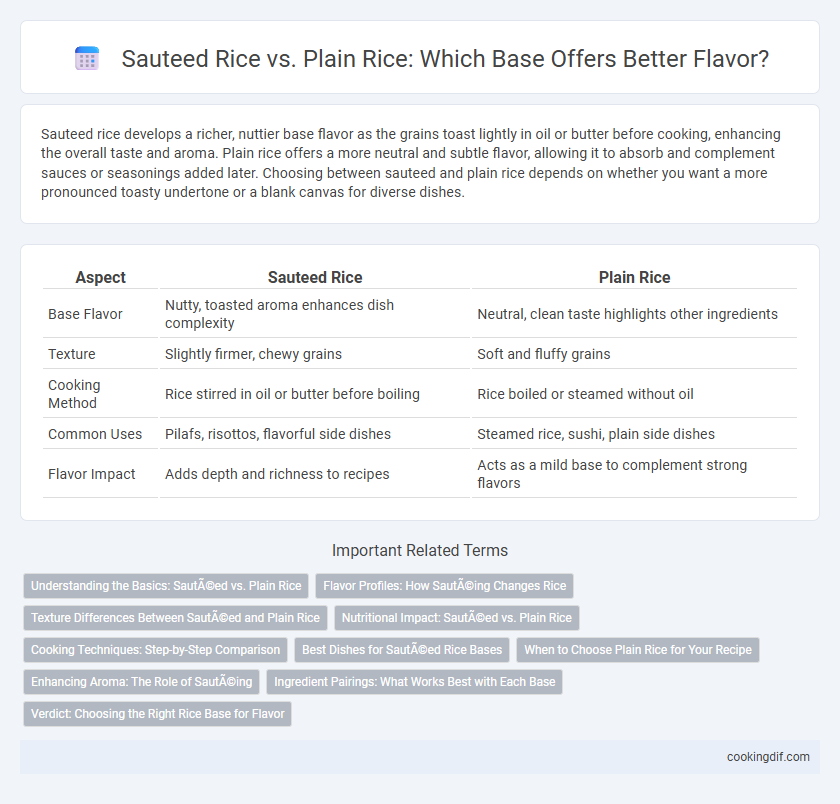Sauteed rice develops a richer, nuttier base flavor as the grains toast lightly in oil or butter before cooking, enhancing the overall taste and aroma. Plain rice offers a more neutral and subtle flavor, allowing it to absorb and complement sauces or seasonings added later. Choosing between sauteed and plain rice depends on whether you want a more pronounced toasty undertone or a blank canvas for diverse dishes.
Table of Comparison
| Aspect | Sauteed Rice | Plain Rice |
|---|---|---|
| Base Flavor | Nutty, toasted aroma enhances dish complexity | Neutral, clean taste highlights other ingredients |
| Texture | Slightly firmer, chewy grains | Soft and fluffy grains |
| Cooking Method | Rice stirred in oil or butter before boiling | Rice boiled or steamed without oil |
| Common Uses | Pilafs, risottos, flavorful side dishes | Steamed rice, sushi, plain side dishes |
| Flavor Impact | Adds depth and richness to recipes | Acts as a mild base to complement strong flavors |
Understanding the Basics: Sautéed vs. Plain Rice
Sauteed rice involves cooking grains in oil or butter before adding water, enhancing its nutty flavor and adding a slight crunch that plain rice lacks. Plain rice is boiled or steamed without added fat, resulting in a neutral taste that absorbs sauces and seasonings more readily. Choosing sauteed rice as a base adds depth and aroma, making it ideal for dishes where rich flavor is desired.
Flavor Profiles: How Sautéing Changes Rice
Sauteed rice develops a nutty, toasted flavor profile through the Maillard reaction, enhancing its aroma and depth compared to plain steamed rice. The process caramelizes the surface starches, resulting in a richer, more complex taste that complements savory dishes. In contrast, plain rice maintains a neutral, mild flavor ideal for absorbing sauces and spices without altering the base character.
Texture Differences Between Sautéed and Plain Rice
Sauteed rice features a toasted, slightly crispy exterior that adds a nutty depth and enhances the overall texture of dishes. Plain rice maintains a soft, tender consistency with a neutral flavor, providing a smooth base that absorbs sauces and seasonings well. This contrast in texture influences the mouthfeel and complexity of the final meal, making sauteed rice ideal for recipes requiring a firmer bite.
Nutritional Impact: Sautéed vs. Plain Rice
Sauteed rice typically contains added oils or butter, increasing its calorie and fat content compared to plain rice, which is lower in calories and fat. Plain rice provides a neutral base with minimal nutritional changes, preserving its natural carbohydrate and nutrient profile. The choice between sauteed and plain rice significantly affects the meal's overall nutritional value, particularly in fat and calorie intake.
Cooking Techniques: Step-by-Step Comparison
Sauteed rice involves toasting the grains in oil or butter before adding liquid, which enhances nutty flavors and creates a slightly firmer texture compared to plain rice. Plain rice is typically rinsed to remove excess starch and cooked directly in water or broth, resulting in a softer, more neutral base flavor ideal for absorbing sauces and spices. This step-by-step technique difference impacts the overall depth and texture, making sauteed rice a preferred choice for dishes requiring a toasted, aromatic foundation.
Best Dishes for Sautéed Rice Bases
Sauteed rice develops a nutty, toasted flavor and firmer texture ideal for dishes like fried rice, jambalaya, and pilaf. This cooking method enhances the taste by caramelizing the rice grains, making it perfect for recipes requiring bold, robust bases. Plain rice offers a neutral foundation best suited for dishes needing subtlety, but sauteed rice provides complexity that elevates spiced or sauce-rich meals.
When to Choose Plain Rice for Your Recipe
Plain rice provides a neutral base that allows the flavors of sauces, spices, or main ingredients to stand out clearly without interference. Choose plain rice when your dish features bold seasonings or complex components that require a subtle foundation to balance and enhance the overall taste. It is ideal for recipes like curry, stir-fries with strong marinades, or stews where the rice should absorb and complement the external flavors rather than compete with them.
Enhancing Aroma: The Role of Sautéing
Sauteing rice before cooking intensifies its aroma by releasing natural oils and toasting the grains, creating a nutty, robust base flavor impossible to achieve with plain rice. The Maillard reaction during sauteing develops complex scent compounds that enrich the sensory experience of any dish. This process also enhances the rice's texture, promoting a separate, fluffier grain that absorbs flavors more effectively.
Ingredient Pairings: What Works Best with Each Base
Sauteed rice offers a nutty, toasted flavor that pairs exceptionally well with robust ingredients like garlic, onions, and spices such as cumin and turmeric, enhancing dishes like pilafs and curries. Plain rice, with its neutral taste, serves as a versatile canvas that complements delicate flavors from ingredients such as steamed vegetables, light sauces, and fresh herbs like cilantro and parsley. Choosing between sauteed and plain rice depends on the desired flavor intensity and ingredient combinations for the dish.
Verdict: Choosing the Right Rice Base for Flavor
Sauteed rice offers a richer, nuttier flavor profile due to the toasting process, enhancing the dish's overall depth and complexity. Plain rice provides a neutral base, allowing other ingredients to shine without altering the intended taste. For flavor-focused recipes, choosing sauteed rice elevates the base, while plain rice suits dishes where subtlety and ingredient prominence are desired.
Sauteed vs plain rice for base flavor Infographic

 cookingdif.com
cookingdif.com